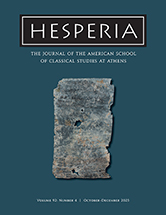Hesperia 92.4 Now Online!

We are pleased to announce the publication of Hesperia 92.4! Topics in this issue include the MYNEKO project in central mainland Greece, the possible evidence for the first Attic potter/painter known by name, a report on the rural fortifications of Aphrodisias, and a curse on a mime actress at Corinth.
Subscribers can read the issue online at Project MUSE, which now hosts current issues of Hesperia as well as an archive of past volumes dating to 2002. Hesperia remains on JSTOR as part of their Arts and Sciences II package, with the usual three-year moving wall. Additionally, all issues of Hesperia from 2011 and earlier are available as Open Access on our website. The printed version will be mailed shortly.
The Mycenaean Northeast Kopaïs Project: A Report from Ayia Marina Pyrgos, by Michael F. Lane, presents the results from the 2016–2018 excavations at Ayia Marina Pyrgos, a site adjacent to the polder around the Late Helladic fortress of Gla in central mainland Greece. The excavations were part of the Mycenaean Northeast Kopaïs Project, or MYNEKO, realized in collaboration with the Hellenic Ministry of Culture and Sports. The article aims to confirm the accuracy of his reconstruction of an irrigated field system in the polder, based on results of the prior AROURA project, and to compare the chronology and nature of occupation at Ayia Marina Pyrgos with those of the field system. Findings corroborated final Middle and Late Helladic dates previously obtained from the polder and showed the site to have experienced significantly different occupation phases.
The Earliest Attic Potter/Painter Known by Name? The Epigraphy and Materiality of an Early Black-Figure Amphora from Mt. Hymettos, by Antonis Kotsonas, examines a black-figure amphora from the sanctuary on Mt. Hymettos that preserves one of the longest Attic inscriptions of the 7th century B.C. This evidence presents a remarkable case for the integration of a postfiring inscription into the morphology of an early Greek vessel. The materiality of the amphora and its lacunose inscription is explored, and a new reconstruction of the text is proposed. The inscription’s peculiar arrangement and unusual verb suggest that it once included one of the earliest signatures of a craftsman in Attica. The study also investigates—but does not embrace—the possibility that the individual mentioned is the earliest Attic potter/painter known by name.
Rural Fortifications in the Region around Aphrodisias, by Christopher Ratté, discusses five rural fortifications in the area around Aphrodisias, recorded in the course of the Aphrodisias Regional Survey (2005–2009). These include, to the north, a “Fluchtburg” and a heavily fortified citadel, and to the south, two isolated towers and a fortress that may be the acropolis of a small settlement. All are datable to the Late Classical and Hellenistic periods. Comparative analysis suggests that they were built independently by members of the regional elite to provide local security, rather than as elements of a coordinated defensive network. Thus they provide valuable information about the social organization and cultural attitudes of the inhabitants of the surrounding area in the early phases of the emergence of the regional urban center at Aphrodisias.
A Curse on a Mime Actress in Corinth, by David. R. Jordan, presents the first edition of a curse tablet of the 4th or 5th century A.D. found in 1969 during the excavation of the “Fountain of the Lamps” in Corinth. The text of 89 lines is addressed to the nymphs and asks for the death and destruction of the mime actress Elpidia. It uses various kinds of voces magicae and charaktêres, and it is accompanied by a drawing of figures that probably represent the nymphs. Indexes of words, personal names, gods, and voces magicae are included.
Subscribe to Hesperia here. In addition to receiving printed issues and online access to Hesperia, subscribers also receive complimentary online access to Hesperia Supplements, and Agora and Corinth volumes.
Hesperia welcomes submissions from scholars working on all aspects of Greek material culture, including archaeology, art, architecture, history, epigraphy, and related studies. Further information about the journal, including instructions for preparing manuscripts for submission, can be found on our website.
The Friends of Hesperia was founded in 2014 to help fund the journal's growth in all its manifestations. We invite you to become a member today and help support one of the most preeminent journals in the field of Mediterranean archaeology.